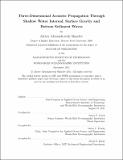| dc.contributor.advisor | James F. Lynch. | en_US |
| dc.contributor.author | Shmelev, Alexey Alexandrovich | en_US |
| dc.contributor.other | Woods Hole Oceanographic Institution. | en_US |
| dc.date.accessioned | 2012-02-28T18:48:39Z | |
| dc.date.available | 2012-02-28T18:48:39Z | |
| dc.date.copyright | 2011 | en_US |
| dc.date.issued | 2011 | en_US |
| dc.identifier.uri | http://hdl.handle.net/1721.1/69241 | |
| dc.description | Thesis (Ph. D.)--Joint Program in Applied Ocean Science and Engineering (Massachusetts Institute of Technology, Dept. of Mechanical Engineering; and the Woods Hole Oceanographic Institution), 2011. | en_US |
| dc.description | This electronic version was submitted by the student author. The certified thesis is available in the Institute Archives and Special Collections. | en_US |
| dc.description | Cataloged from PDF version of thesis. | en_US |
| dc.description | Includes bibliographical references (p. 185-193). | en_US |
| dc.description.abstract | This thesis describes the physics of fully three-dimensional low frequency acoustic interaction with internal waves, bottom sediment waves and surface swell waves that are often observed in shallow waters and on continental slopes. A simple idealized model of the ocean waveguide is used to analytically study the properties of acoustic normal modes and their perturbations due to waves of each type. The combined approach of a semi-quantitative study based on the geometrical acoustics approximation and on fully three-dimensional coupled mode numerical modeling is used to examine the azimuthal dependence of sound wave horizontal reflection from, transmission through and ducting between straight parallel waves of each type. The impact of the natural crossings of nonlinear internal waves on horizontally ducted sound energy is studied theoretically and modeled numerically using a three-dimensional parabolic equation acoustic propagation code. A realistic sea surface elevation is synthesized from the directional spectrum of long swells and used for three-dimensional numerical modeling of acoustic propagation. As a result, considerable normal mode amplitude scintillations were observed and shown to be strongly dependent on horizontal azimuth, range and mode number. Full field numerical modeling of low frequency sound propagation through large sand waves located on a sloped bottom was performed using the high resolution bathymetry of the mouth of San Francisco Bay. Very strong acoustic ducting is shown to steer acoustic energy beams along the sand wave's curved crests. | en_US |
| dc.description.statementofresponsibility | by Alexey Alexandrovich Shmelev. | en_US |
| dc.format.extent | 193 p. | en_US |
| dc.language.iso | eng | en_US |
| dc.publisher | Massachusetts Institute of Technology | en_US |
| dc.rights | M.I.T. theses are protected by
copyright. They may be viewed from this source for any purpose, but
reproduction or distribution in any format is prohibited without written
permission. See provided URL for inquiries about permission. | en_US |
| dc.rights.uri | http://dspace.mit.edu/handle/1721.1/7582 | en_US |
| dc.subject | Joint Program in Applied Ocean Science and Engineering. | en_US |
| dc.subject | Mechanical Engineering. | en_US |
| dc.subject | Woods Hole Oceanographic Institution. | en_US |
| dc.subject.lcsh | Acoustic models | en_US |
| dc.subject.lcsh | Internal waves | en_US |
| dc.title | Three-dimensional acoustic propagation through shallow water internal, surface gravity and bottom sediment waves | en_US |
| dc.type | Thesis | en_US |
| dc.description.degree | Ph.D. | en_US |
| dc.contributor.department | Joint Program in Applied Ocean Physics and Engineering | en_US |
| dc.contributor.department | Woods Hole Oceanographic Institution | en_US |
| dc.contributor.department | Massachusetts Institute of Technology. Department of Mechanical Engineering | |
| dc.identifier.oclc | 775671835 | en_US |
